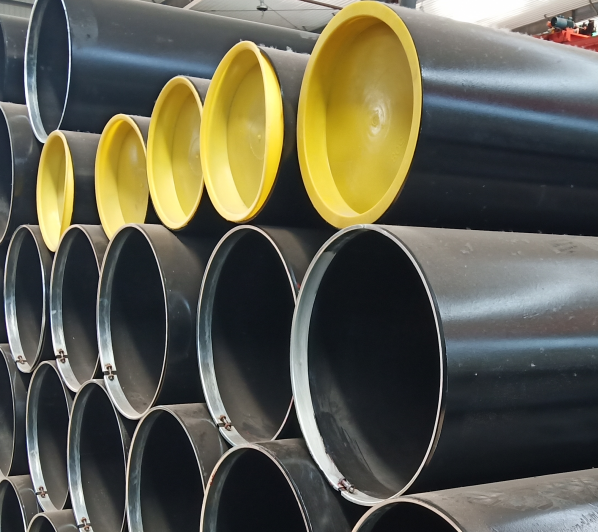Welded steel pipe is a steel pipe welded with steel plates or steel strips. Welded steel pipes have the advantages of simple production process, high production efficiency, many varieties, and low equipment costs, but their overall strength is lower than seamless pipes.
Welded steel pipes can be divided into straight seam welded pipes (LSAW and
ERW Pipe) and
spiral welded pipes (SSAW Pipe). The straight seam welded pipe process is simple, has high production efficiency, low cost and is developing rapidly. The strength of spiral welded pipes is generally higher than that of straight welded pipes, and welded pipes of different diameters can be produced with the same billet width. However, compared with straight seam pipes of the same length, the weld lengths are increased by 30% and 100% respectively, and the production speed is lower. Therefore, most small diameter straight seam welded pipes are mostly spiral welded. This article will introduce the types of welded steel pipes.

1. Welded steel pipes can be used for low-pressure fluid transportation, also known as ordinary welded pipes, commonly known as black pipes. Used to transport low-pressure liquid water, air, gas, oil, steam heating, etc. Steel pipes for connection are divided into ordinary steel pipes and thickened steel pipes according to wall thickness. According to wall thickness, they are divided into unthreaded steel pipes (smooth steel pipes) and threaded steel pipes. Steel pipe specifications are expressed in nominal diameter (mm), which is an approximate value of the inner diameter. It is customary to use inches, such as 11 inches, 2 inches, etc. Welded steel pipes are used for low-pressure fluids. They are not only used to directly transport fluids, but can also be used as raw materials for low-pressure galvanized welded steel pipes.
2. Galvanized welded steel pipes can be used to transport low-pressure working fluids, also known as galvanized welded steel pipes, commonly known as white pipes. It is used to transport water, gas, gas, oil and other general low-pressure fluids, such as heating steam, warm water or other hot-dip galvanized welded steel pipes (electric furnace welding or electric welding). Steel pipe walls are divided into ordinary galvanized steel pipes and galvanized thick steel pipes, galvanized steel pipes and threaded galvanized steel plates without threads. Steel pipe specifications are expressed in nominal diameter (mm), which is an approximate value of the inner diameter. Usually inches are used, such as 11x2, etc.
3. Ordinary carbon steel casing is a protective casing for industrial and civil buildings, installation of wire machinery and other equipment, and electrical equipment.
4. Straight seam welded steel pipe is a parallel steel pipe studied along the longitudinal direction of the steel pipe. It can usually be divided into metric welding process steel pipes, welding material thin-walled steel pipes, transformer cooling pipes, etc.
5. Spiral submerged arc welded steel pipe is a spiral welded steel pipe formed from hot rolled strip steel and often formed at high temperature. Double-sided submerged arc welding is used for pressure fluid transfer. Steel pipes have strong load-bearing capacity and good weldability. After various rigorous scientific and technical inspections and experiments, it is reliable in use. Mainly used for pipeline transportation of oil and natural gas.
6. Spiral seam high-frequency welded steel pipes for pressure fluid transportation are spiral seam high-frequency welded steel pipes, which are welded by high-frequency lap jointing methods. Hot rolled steel strip coils are often used as tube blanks. Strong bearing steel and plastic are easy to weld and process. After various rigorous scientific inspections and tests, it is reliable in use and is mainly used for the laying of oil and natural gas pipelines.
7. The spiral submerged arc welded steel pipe for low-pressure transportation uses hot-rolled strip steel as the blank, the spiral submerged arc welded steel pipe is a normal-temperature spiral low-pressure transportation steel pipe, and the hot-rolled strip steel is a normal-temperature spiral low-pressure transportation steel pipe. Rolled steel strip is a kind of tube blank. Used for general water, gas, steam and other low-pressure fluid transportation.
8. Generally, spiral seam high-frequency welded steel pipes for low-pressure fluid transportation mainly use hot-rolled strip steel as the tube blank and are formed at room temperature. The high-frequency lap joint method is used to weld spiral welded high-frequency welded steel pipes. Generally used for low pressure fluid transportation.
Tips: ASTM A53 covers seamless and welded steel pipe with nominal wall thickness. The surface condition is usually black and hot-dipped galvanized. ASTM A53 is produced mainly for pressure and mechanical applications, and is also used for transport of steam, water, gas line pipes.


